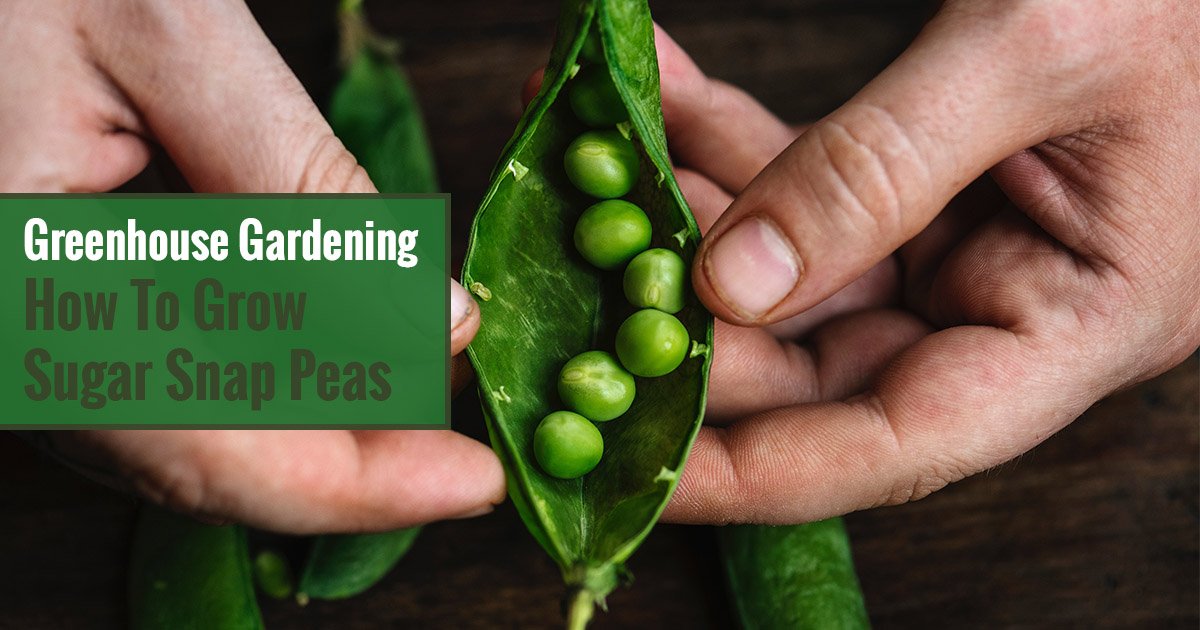
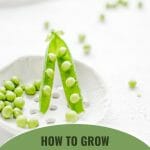


Peas are often one of the very first plants to start growing in early spring, when temperatures may still be cold but the ground is beginning to thaw. If you’re getting impatient, we can’t blame you: fresh peas are irresistible! Luckily, with the help of a greenhouse you can grow peas earlier and later than your climate would otherwise allow.
Most peas are fairly simple to grow in the garden, but is the same true for a greenhouse? You’ll be happy to learn that as long as greenhouse temperatures are cool (not cold or hot), peas are sure to thrive. You can plant peas in big containers, raised beds, or even in seedling trays to be transplanted later.
Although peas are a relatively straightforward crop to grow, you’ll still need to pay attention to factors such as water, light, soil, pests, and diseases. But don’t worry, we cover all of these topics in this article, so keep reading to learn all about how to grow peas in a greenhouse!
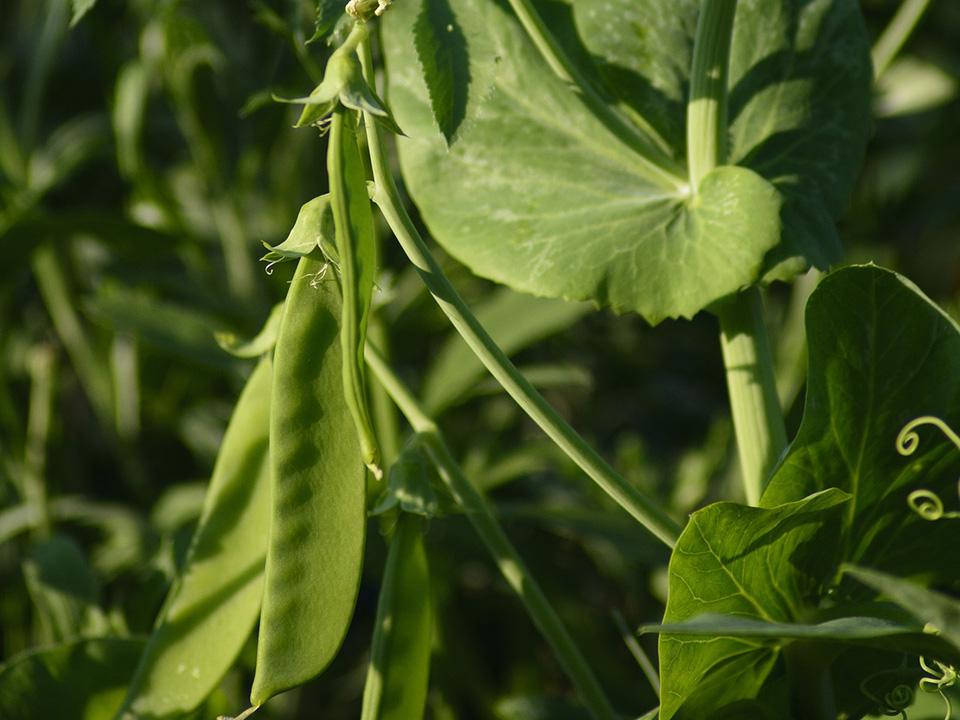
Quick overview of how to grow peas in a greenhouse
- Type: Cool-season crop
- Time from seed to harvest: 60 days
- Germination temp: 40-85°F
- Time until first emergence: 9-13 days
- Best temp to grow: 50-70°F
- Height: 1-8 ft
- Spread: 6-12 in
- Light: Full sun
- Grow from seed: 1-2 in deep, 1-4 in apart; rows 18 in apart
- Companions: Radish, beans, corn, cucumber, peppers, spinach, strawberries, and turnips
- Keep away from: Onions, chives, leeks, scallions, and shallots
Why grow peas in a greenhouse?
If you’re looking for the sweet taste of fresh peas, there’s no better solution than growing them yourself. If you want to enjoy these tasty snacks all season long, there’s no better way to do so than with the help of a greenhouse, which allows you to get an early start on the growing season. If you live in a mild climate, or if you are willing to keep your greenhouse heated during the winter, you may even be able to grow them all-year long, even in late winter!

Additionally, a greenhouse protects your young pea plants from extreme weather, harsh frosts, and hungry animals – all of which can lay waste to an entire crop of peas.
Different varieties of peas to grow in a greenhouse
When selecting which peas to grow in a greenhouse, you’ll find that there are many varieties to choose from. Most varieties fall into one of four main types of peas: snow peas, sugar snap peas, shelling peas, and sweet peas.
Let’s take a closer look at these four types of peas:
Snow peas
Snow peas are slender in appearance and can range in color from green to purple. They are known for their sweet and crisp edible pods, which are ideal for fresh eating, adding to a salad, or serving as a side. Snow pea pods are picked when the peas are only just starting to form.
Snow peas are available in both vining and bush types. If you have the space, we recommend choosing a vining type as it will produce for a longer period of time. If you’re limited on space, or you just want a quick burst of peas, bush peas may be a better option for you.
Our favorite variety of snow pea is the Blizzard Snow Pea, which is known for its crisp pods and easy harvesting.
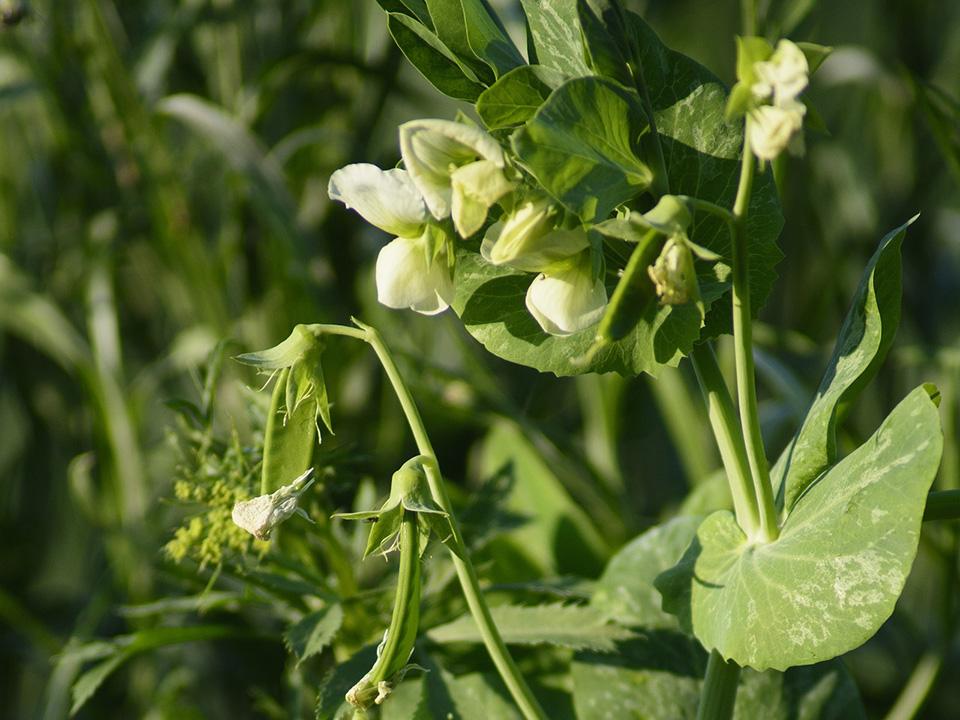
Sugar snap peas
One of the most common types of peas to grow at home is the sugar snap pea. Fresh sugar snap peas are crunchy, refreshing, and sweet, making for a tasty snack while gardening.
Sugar snap peas can be vining or bush type, but we recommend the vining type because they produce more. For best results, choose a variety that has been bred for disease resistance, such as the Sweet Gem Snap Pea.
Shelling peas
Shelling peas, also known as “garden peas” or “English peas,” are grown for their sweet green peas which can be cooked, frozen, eaten fresh, or dried. The pod of shelling peas is tough and not considered edible, though you could technically harvest the pods early for fresh eating as you would with snow or sugar snap peas.
Most shelling pea varieties are vining, but you can find some compact varieties that don’t require trellising, like the Iona Shelling Petite Pea, one of our favorites to grow in the greenhouse.
Sweet peas
A less common type of pea is the sweet pea. Although sweet peas don’t make for good eating, they produce many beautiful, sweet-smelling flowers in a variety of colors, typically shades of pink, purple, and white. Most sweet peas are vining and require some form of support structure.
For the most vibrant effect, select a sweet pea blend. We recommend the Perfume Delight Sweet Pea Blend for its exquisite fragrance and bright colors.

How to plant peas in a greenhouse
The process of planting peas in a greenhouse is similar to planting them outdoors. You can plant peas as soon as soil temperatures reach above 40°F in your greenhouse, which may be several weeks earlier than the soil outside. For ideal conditions, wait until the daytime air temperature in your greenhouse reaches 60°F.
You can plant peas from seed directly into your greenhouse garden beds, or grow them in modular trays for transplanting outdoors. Since pea roots don’t like to be disturbed, it’s best to sow from seed, though you can be successful with transplants if you follow a few simple tricks. We take a look at both methods below:
Planting peas from seed
To plant peas from seed in a greenhouse:
- If your peas are a vining variety, they will require a trellis for climbing. Place the trellis a few inches behind where you will be sowing the seeds. Doing so prevents the soil from being disturbed after sowing, and it also acts as a guide for where to sow the seeds.
- Sow peas 1-2 inches deep and 2 inches apart, in rows 18 inches apart.
- Gently tamp the soil around the seeds, covering with about ½ inch of soil.
- Water the seeds carefully until the soil is moist.
- Depending on the temperature, pea shoots may start to emerge after a few days. After plant growth reaches 8 inches, carefully cut off the tips to encourage branching.
Transplanting pea seedlings
While peas are best grown directly from seed, it’s possible to transplant seedlings bought from a nursery or grown in seedling trays. If you are growing your own seedlings, try growing them in biodegradable seedling pots to transplant directly into the soil, pot and all. Alternatively, start your peas in a gutter with a removable end. The gutter makes for easy transplanting: simply slide the peas out into a pre-dug trench in the soil.
To grow your own pea seedlings, simply follow the instructions from above, but plant them into your preferred seedling container instead of the ground. Use a seedling heat mat to encourage germination if greenhouse temperatures are below 60°F.
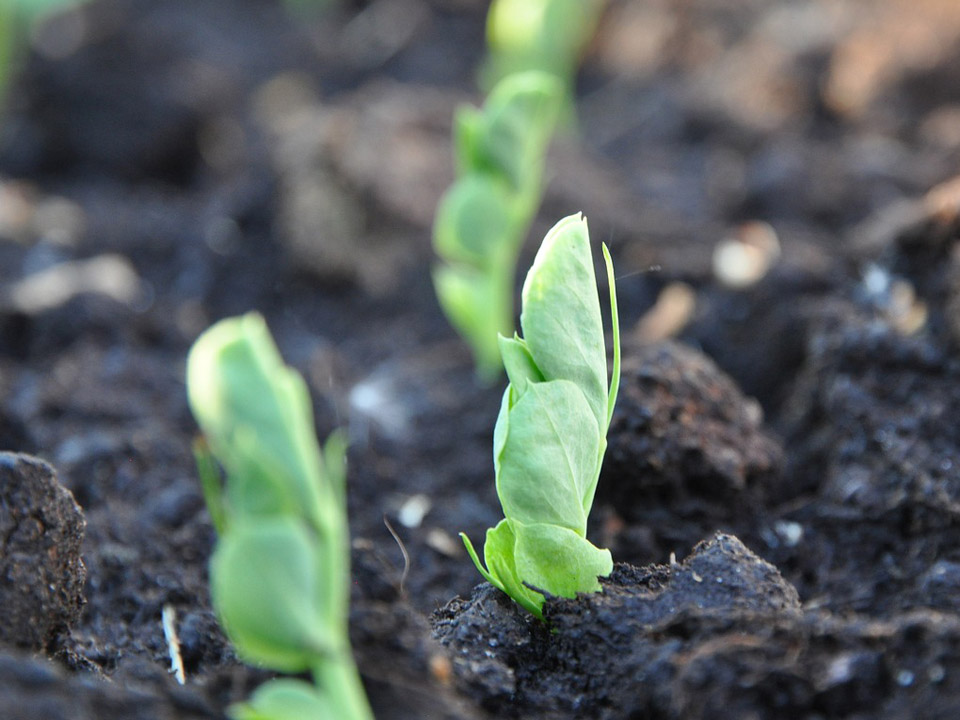
Once the seedlings reach just 3 inches tall, transplant them into their final location in the garden or greenhouse. Here are some tips for successful transplantation:
- Make sure the soil of both the seedlings and the final location is moist, not soggy or overly dry. Dry soil will crumble and expose the roots, while soggy soil may suffocate them.
- Before transplanting, dig a trench where your pea seedlings will go and set up a trellising system to minimize soil disturbance later.
- Don’t wait too long to transplant pea seedlings; the bigger they get, the more developed and prone to disturbance their root systems will be.
- Gently water the seedlings once transplanted.
- When they reach 8-12 inches tall, carefully trim the tips to stimulate branching.
How to care for peas in a greenhouse
Peas are fast growers and need minimal care, but that doesn’t mean they can be ignored entirely. To make the most of your greenhouse pea crop, make sure that you are providing them with fertile soil and plenty of water and light.
Best soil for peas
Peas grow well in a variety of soil types with a pH between 6-7.5 You can perform a simple soil test with a pH meter, or get it tested professionally.
Peas don’t require much fertilizer, but it’s still a good idea to mulch generously with rich compost or well-rotted manure. Besides improving soil quality, this insulates the roots.
Best temperature and lighting for peas
Peas will grow well in a greenhouse as long as temperatures remain above 45°F and below 85°F. Ideal daytime temperature for peas is around 75°F. Once temperatures exceed 85°F for a few days, peas stop producing.
Peas grow best with at least six hours of full sun every day, but too much sunlight can hurt them, so some shading may be necessary if your greenhouse is in a particularly sunny location. By contrast, artificial grow lights may be needed during winter.
How much to water peas
Peas are not drought-tolerant and do best in consistently moist soil. While you can plant them in big containers or raised beds, make sure they are kept well irrigated. But watch out! Too much water can suffocate the roots and lead to root rot, so make sure that the soil (whether in a container or in the ground) has good drainage.
Common pests and diseases
In the garden, young plants are susceptible to being snacked on by humans, birds, and rats. If your greenhouse is properly sealed, you shouldn’t have to worry about the latter two. That said, insects and diseases can still get inside a greenhouse through open windows, new plants, or even your tools.
Watch out for:
- Thrips and aphids, which can create deformity of the leaves and pods. To get rid of these pests, spray your plants with a diluted insecticidal detergent, making sure to follow product instructions.
- Silvery webs on the undersides of leaves may be the work of spider mites, which can damage your peas. It can be washed away with insecticidal soap or plain water.
- Brownish or yellowish specks on leaf surfaces may point to powdery mildew. You can prune infected plant parts, but if an entire plant is infected you may need to remove it entirely. Prevent powdery mildew by making sure your greenhouse has good air circulation and ventilation.
When to harvest peas
The best time to harvest greenhouse-grown peas depends on the type. Sugar snap peas are best harvested when the pods are swollen. Don’t wait for too long because they can grow tough if left on the vine too long. Snow peas are best picked as soon as the peas start to develop (you’ll notice little round bumps on the pods). Harvest shelling peas when the pods start to fatten. Pick sweet pea flowers as soon as they open and keep them in a vase of water, or simply leave them on the vine to enjoy their scent in the greenhouse.
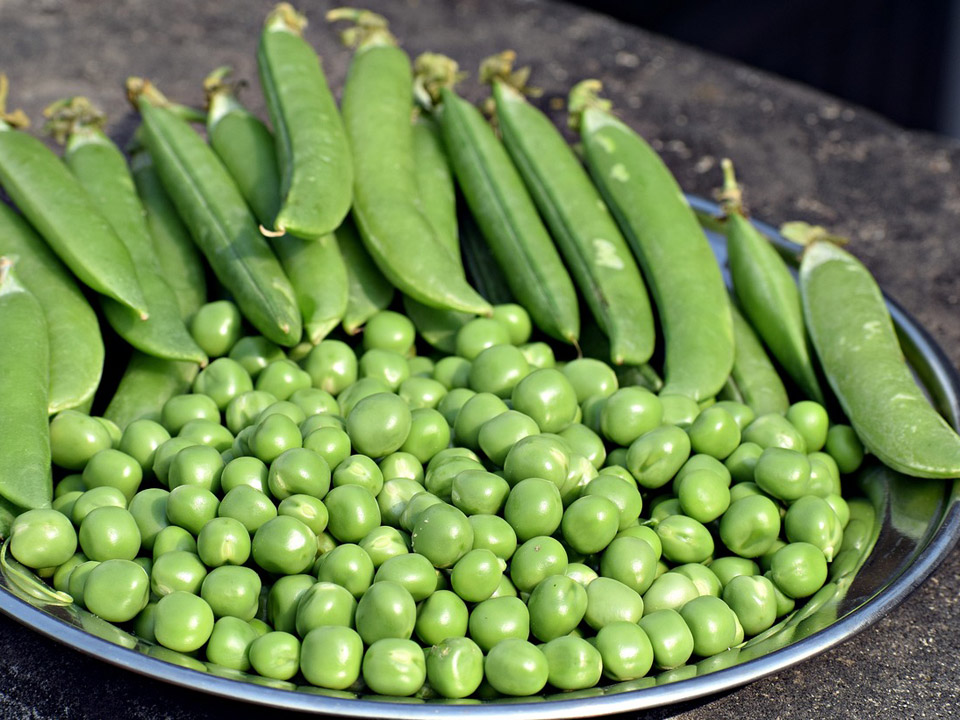
To harvest pea pods without damaging the rest of the plant, grab the stem with one hand and pull the pod off with the other. Alternatively, use sharp, clean garden shears to cut the pods off. Only use shears when harvesting sweet pea flowers to avoid damaging the stem.
With all types of peas, regular picking promotes continuous production. If you quit picking for a while, the plant may stop producing altogether.
FAQs about growing peas in a greenhouse
Can I grow peas hydroponically?
If you have a hydroponic set up in your greenhouse and are wondering if you can grow peas in it, yes you can! Peas are pretty forgiving and require a fairly simple nutrient solution, so you can definitely grow them this way. Learn more about growing peas hydroponically from IGWorks.
Will peas grow in summer?
Because peas are a cool weather crop, they are best grown in the shoulder seasons: spring and fall. In fact, pea plants will stop producing once temperatures exceed 85°F even for just a few days. Unless you live in a climate that experiences cool summers, or you are willing to cool your greenhouse, peas may not grow in the summer.
Are peas frost tolerant?
As cool season crops, peas are fairly frost-tolerant, able to survive temperatures as low as 20°F! However, lower temperatures, extended periods of freezing, or high winds can damage pea plants. If you’re growing peas in an unheated greenhouse and the temperature is threatening to drop considerably, you can protect your pea plants by covering them with a frost cloth.

